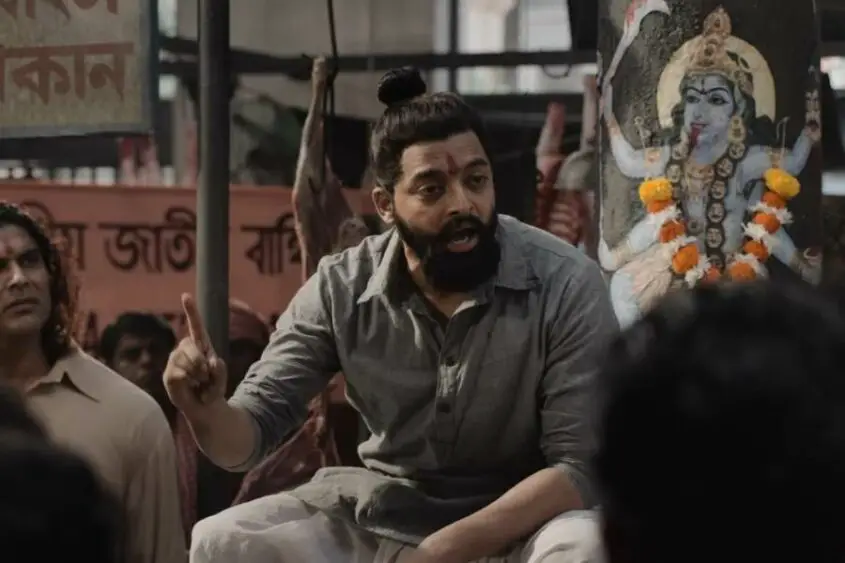There’s an urgency to The Bengal Files — a sense that something vital is being said, or at least attempted. Agnihotri sets the stage with bold questions — can violence ever be neutral, detached from community? There is a responsibility in retelling history. Some events demand precision, others demand empathy. Direct Action Day of 1946 demands both. The Bengal Files, directed by Vivek Agnihotri, aims to close out a trilogy of films that wrestle with India’s troubled past.
This time, the canvas is Bengal, its communal scars, and the unending debate over violence and justice. The film opens with a promise, a rare chance to confront forgotten wounds. But as the story progresses, that promise begins to fray. It’s a film that begins in fire and ends in fatigue — fierce in intention, but weary in execution. The imagery of Maa Durga rising in the background is powerful, reminding us that symbols can say more than words. And yet, Agnihotri’s storytelling falters. The central question lingers: can Ram Rajya be built without first killing Ravan? It’s a question both timeless and dangerous. The film poses it, but never dares to answer — perhaps because doing so would mean confronting not just history, but the uncomfortable truths of our present, where faith and politics still dance on the same fragile ground.
The dual timeline is the culprit. On one side, we have Shiva Pandit investigating a journalist’s abduction. On the other hand, the brutal violence of 1946’s Direct Action Day. Contrast this with The Kashmir Files. That film worked because the suffering was Shiva’s own. The exile of Kashmiri Pandits was personal, immediate. Here, the same character feels detached, like a narrator in someone else’s tragedy. And that detachment kills urgency. What should shock us into outrage ends up feeling like a distant echo. Worse, sentimentality clouds the narrative. The film wants us to weep but forgets to first make us feel.
The bridge between past and present is Bharti Banerjee, but the math doesn’t add up. If anyone survived those riots, they would be nearing a century old, not a youthful guide in the present day. Instead of tightening the link, the film bends reality and breaks believability. This collapse of realism is not nitpicking; it breaks the historical backbone of the film.
The tragedy is that the material is so rich. Noakhali, the riots, the betrayals — all of it cries for unflinching depiction. Redditors and historians alike remind us that the horror was beyond what the film shows. The intention behind the film is noble: to remind us that Partition was not destiny but design, engineered by powerful men for their own gain. Yet, intention is no substitute for clarity in storytelling. The film blurs its antagonist until violence itself becomes a fog — everyone guilty, everyone innocent. That is not how history unfolded. Men did profit. Communities were scarred. To erase that truth is to dilute the very injustice the film seeks to highlight.
Agnihotri tries to argue that violence doesn’t wear the cloak of religion. It is true, and yet by refusing to show the real culprit, the film feels diluted. The urgency, the raw injustice of history, gets muffled beneath sentimentality. The result is a narrative that feels hypothetical, not historical. Violence becomes symbolic when it should have been specific.
The writing doesn’t help either. A Sikh character enters and asks Bharti a clumsy question: “Who are you?” It’s the kind of dialogue that belongs in a soap opera, not a historical drama. Attempts to weave romance into the plot feel equally misplaced. When depicting something as horrific as Noakhali, you don’t need decorative subplots. Trauma itself forges relationships stronger than any scripted love story. In moments where the camera should have stayed on the carnage, it turns away. When we should feel the unbearable silence of loss, we are fed clumsy banter.
It’s not just bad writing — it’s misplaced priorities. The audience is left adrift, waiting for the story that never arrives. To soften that horror with melodrama feels not just unnecessary but dishonest.
Still, moments of brilliance exist. One monologue between Bharti and Amar touches on the essence of Bengali identity — its literature, music, journalism, and intellectual life. Here, the film strikes home. That moment makes you ache for the film that could have been — one that honoured Bengal’s past while confronting its darkest hours. Bengal has always been India’s lighthouse. The dialogue reminds us that knowing our roots isn’t optional; it’s essential. Without them, we drift into emptiness. This sequence alone shows what Agnihotri might have achieved with more discipline and less indulgence.
Swami Vivekananda once said, “Give me 100 committed Indians and we will change the destiny of India.” The film attempts something similar: to resurrect a moment of history and hold it before us. But destiny demands clarity. The Bengal Files instead wavers, dilutes, and slips into confusion. What should have been a searing retelling becomes a muddled memory. History deserves better. Direct Action Day deserves better. And Bengal — land of Tagore, Ray, and Bose — deserves a film that understands its pain without turning away. History deserved a roar. The film manages only a whisper.
It wants to be profound but ends up merely provocative, mistaking volume for depth. In trying to say everything, it ends up saying little — a tragedy not just of craft, but of conviction, where emotion is present, yet meaning quietly slips through the cracks of ambition.
By Sujay Sarkar

